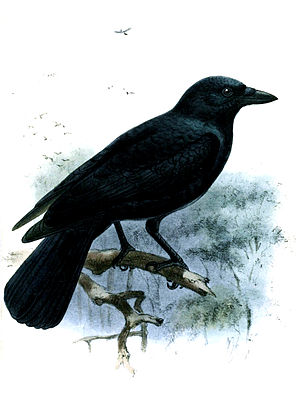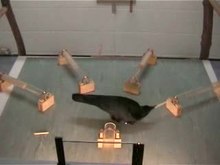Straight-billed crow
| Straight-billed crow | ||||||||||||
|---|---|---|---|---|---|---|---|---|---|---|---|---|

Straight-billed crow, drawing by John Gerrard Keulemans |
||||||||||||
| Systematics | ||||||||||||
|
||||||||||||
| Scientific name | ||||||||||||
| Corvus moneduloides | ||||||||||||
| Lesson , 1831 |
The straight-billed crow ( Corvus moneduloides ), also known as the New Caledonia crow , is a bird belonging to the genus of ravens and crows ( Corvus ). It occurs exclusively in New Caledonia and the Loyalty Islands . Straight-billed crows feed primarily on wood-dwelling larvae and nuts, but also use many other food sources. They are able to convert various objects into tools to get at their food. They are considered to be the most intelligent birds because they have sequential intelligence (using different objects as tools one after the other to achieve a goal); a quality that otherwise only chimpanzees or humans have.
features
Build and color
Between the sexes of the New Caledonian crow is neither in the plumage coloration still in Build a dimorphism , the same applies to young and adult birds. It reaches a body length of around 40 cm. The beak is comparatively short for a crow with 42–50 mm. Its ridge is very flat and the gonys angle is correspondingly pronounced. The straight-billed crow has a wing length of 241–267 mm, its tail measures 170–186 mm. The tarsometatarsus reaches a length of 42–48 mm. The weight is between 230 and 330 g. The straight-billed crow has one of the largest brains of all bird species in relation to its size and weight.
The plumage of the straight-billed crow is uniformly black and has a purple-dark blue sheen; the wings of the hand have a pale greenish sheen on the outer flags, as do the coverts . The throat feathers are very fine and hairy. The straight-billed crow's tail is relatively long and rounded at the end or slightly tiered. The bill, toes and legs are black. The iris is dark brown.
voice
The call of the straight-billed crow consists of a soft, hoarse and high waaaw . She also calls louder with a high wak-wak and a long, shrill aaup . A comparatively melodious, soft wa-wa call probably serves as a hate signal or a warning call for danger from the ground. It is uttered, for example, when a person approaches, whereupon the birds fly towards him.
distribution
The distribution area of the straight-billed crow includes the islands of Grande Terre and Maré . While the New Caledonian main island Grande Terre is the original home of the species, it was naturalized by humans in Maré , which belongs to the Loyalty Islands , and was able to establish itself there.
habitat
Trees of varying density characterize all the straight-billed crow habitats. It inhabits both dry forests and open landscapes with at least a few trees, such as the savannah with myrtle heather ( Melaleuca quinquenervia ) .
Way of life
nutrition

The food of the straight-billed crow consists mainly of longhorn beetle larvae of the species Agrianome fairmairei and the fruits of the light walnut tree ( Aleurites moluccana ). In addition, other fruits, seeds and flowers of coral trees ( Erythrina spp.), Snails, lizards, adult insects and carrion can also be found in the food spectrum. Occasionally eggs and chicks are eaten by domestic chickens and other birds.
The straight-billed crow opens snails, nuts and other hard-shelled fruits by smacking them against rocks or buttress roots from a great height or by pounding them with its beak on hard ground. It catches nocturnal insects from flight at dusk and is capable of agile maneuvers. Longhorn beetle larvae are fished from their holes in decaying wood stumps with the help of special tools . To do this, the straight-billed crow forms fine poking instruments from screw tree leaves or from leaf stalks and branches of the light walnut tree, which reach deep into the corridors. Then she carefully feels it in the holes until she encounters a larva. This is pushed until it bites its mouthparts at the end of the tool and can be pulled out of the hole. The exact form of these tools varies from individual to individual.
Social behavior
Straight-billed crows often move in pairs, after the hatchling of the young birds also in family groups. Occasionally the animals can also be found alone. Unlike many other Corvus species, the straight-billed crow usually does not form large social groups, although there have been reports of flocks of around 30 birds.
Reproduction and breeding
Nests of the straight-billed crow consist of thin twigs layered to form a platform and are interwoven with root and leaf fibers. They are usually built very high in trees. The female lays two to three eggs between September and November. They are white, have a slightly bluish or greenish tint and are densely covered with olive, brown and gray speckles.
Systematics and taxonomy
The first description of the straight-billed crow can be found in the fifth volume of René Primevère Lessons Traité d'Ornithologie , which appeared in 1831. In it he listed the species Corvus moneduloides in the group of "jackdaws", to which he counted all crows of small size, gray neck or more or less short beak. The straight-billed crow also owes the specific epithet moneduloides to this kinship assumed by Lesson , which was intended to emphasize the similarity to the Eurasian jackdaw ( C. monedula ). Lesson gave for his first description - as was often the case at the time - neither a list of features nor a holotype or a type locality . The name " Corvus caledonicus " Gmelin , 1788 is not available as the basionym of the Welchmann caterpillar catcher ( Coracina caledonica ) and would also be reserved in the form of Latham , 1790 for the white-necked elk ( Streptocitta albicollis ).
The straight-billed crow comes from a radiation of the ravens and crows ( Corvus ), which took place in the late Miocene (~ 5 mya ) in what is now New Guinea . Analyzes of mitochondrial and nuclear DNA sequences reveal a clade formed by the red-billed crow ( C. woodfordi ) and bougainville crows ( C. meeki ) as a sister line of the red-billed crow. The common sister species of the three crows is the Moluccan crow ( C. validus ).
Inventory and status
Nothing is known about the number of the straight-billed crow on Grande Terre and Maré, but it is considered a common bird, both in cultivated landscapes and in original vegetation. Although the IUCN sees the decline of the forests on Grande Terre as a threat to the population there, it lists the species under the Least Concern category (no threat).
Sources and References
literature
- Lucas A. Bluff, Jolyon Troscianko, Alex AS Weir, Alex Kacelnik, Christian Rutz: Tool use by wild New Caledonian crows Corvus moneduloides at natural foraging sites. In: Proceedings of the Royal Society of Biological Sciences 277, 2010. doi : 10.1098 / rspb.2009.1953 , 1377-1385
- Julia Cnotka, Onur Güntürkün , Gerd Rehkämper, Russell D. Gray, Gavin R. Hunt: Extraordinary large brains in tool-using New Caledonian crows (Corvus moneduloides). In: Neuroscience Letters 433, 2008. pp. 241-245. (Online as PDF )
- Dieter Glandt: Kolkrabe & Co. AULA-Verlag, Wiebelsheim; 2012. ISBN 978-3-89104-760-6
- Johann Friedrich Gmelin: Caroli a Linné systema naturae per regna tria naturae, secundum classes, ordines, genera, species, cum characteribus, differentiis, synonymis, locis… Editio decima tertia, aucta, reformata. Tomus I. Georg Emanuel Beer, Leipzig 1788–1793. ( Full text )
- Derek Goodwin : Crows of the World. 2nd Edition. The British Museum of Natural History, London 1986, ISBN 0-565-00979-6 .
- Knud A Jønsson, Pierre-Henri Fabre, Martin Irestedt: Brains, Tools, Innovation and Biogeography in Crows and Ravens. In: BMC Evolutionary Biology 12 (72), 2012. doi : 10.1186 / 1471-2148-12-72 .
- John Latham: Index ornithologicus sive Systema ornithologiæ. London 1790. ( full text )
- Steve Madge , Hilary Burn: Crows & Jays. Princeton University Press, Princeton 1994, ISBN 0-691-08883-7 .
- Ernst Mayr , James C. Greenway, Jr. (Ed.): Check-List of Birds of the World. A Continuation of the Work of James L. Peters. Volume IX. Museum of Comparative Zoology, Cambridge 1960. ( full text )
- Ernst Mayr, James C. Greenway, Jr. (Ed.): Check-List of Birds of the World. A Continuation of the Work of James L. Peters. Volume XV. Museum of Comparative Zoology, Cambridge 1962. ( full text )
- René Primevère Lesson: Traité d'Ornithologie, ou Tableau Méthodique des Ordres, Sous-ordres, Familles, Tribus, Genres, Sous-genres et Races d'Oiseaux. FG Levrault, Paris 1831. ( full text )
- Christian Rutz, Lucas A. Bluff, Nicola Reed, Jolyon Troscianko, Jason Newton, Richard Inger, Alex Kacelnik, Stuart Bearhop: The Ecological Significance of Tool Use in New Caledonian Crows. In: Science 329 (5998), 2010. doi : 10.1126 / science.1192053 , pp. 1523-1526.
Web links
- Corvus moneduloides in the endangered Red List species the IUCN 2008. Posted by: BirdLife International, 2008. Accessed on January 1 of 2009.
- Videos, photos and sound recordings of Corvus moneduloides in the Internet Bird Collection
Individual evidence
- ↑ a b Lesson 1831, p. 329.
- ↑ Madge & Burn 1994 , p. 140.
- ↑ Cnotka et al. 2008 , p. 243.
- ↑ a b c d Goodwin 1986 , p. 109.
- ↑ a b c d Madge & Burn 1994 , p. 141.
- ↑ a b c IUCN 2008 . Retrieved August 12, 2011.
- ↑ Rutz et al. 2010 , p. 1524.
- ↑ Madge & Burn 1994 , pp. 140-141.
- ↑ Michelle Starr: Crows Can Build Compound Tools Out of Multiple Parts, And Are You Even Surprised. In: Science Alert. October 25, 2018, Retrieved April 4, 2020 (UK English).
- ↑ Bluff et al. 2010 , pp. 1377-1378.
- ↑ Rutz et al. 2010 , p. 1523.
- ↑ Mayr & Greenway 1962, p. 117.
- ↑ Latham 1788, p. 154.
- ↑ Mayr & Greenway 1960, p. 174.
- ↑ Jønsson et al. 2012 , p. 23.

